Page 138 of 402
Downloaded from www.Manualslib.com manuals search engine Section 4 Your Driving. and the- Road
Were-. you’ll find information ,ab.aut driving on different kinds o.frodds and in varyir@ weatkr-er c’oiiditians. We”ve ako
inc1ude.d many other useful tips ;on driving.
4-2
4-3
4-6
4-6
4-5)
4-1
1
4-12
4-13
4-14
4-2.9
4-3..1
4-34
4-35
Defmsive.Driving
Drunken Driving
Control of a Vehicle
Braking
Steering
Off-Road Recovery
Passing
Loss. of Control
Driving Guidelines
Diiving at-Night
Driving in Rain .and on Wet Roads
City Driving
Freeway Driving
4-3 6
4-37
437
4-39
4-43
4-43
4--44-
4-49
4-49
B-ef6x.e Leaving- on a Long Trip
Hi,ghway
Hypnosis
Hill and Mountain Roads
Wint-eter DriviQg
Recreaii-ana;l Vehide Tbwing
(Four-Wheel .Drive with: the. Manual
Shift Transfer Ca$e Only)
Recreational
Vehicle Towitlg (Except
Four-wheel Drive with the Manud
SMt ~ Transfe-r Ca,s e)
Loading Your Vehic1.e
Pickup Conversion to Chassis Cab
Towing a Trailer
Page 181 of 402
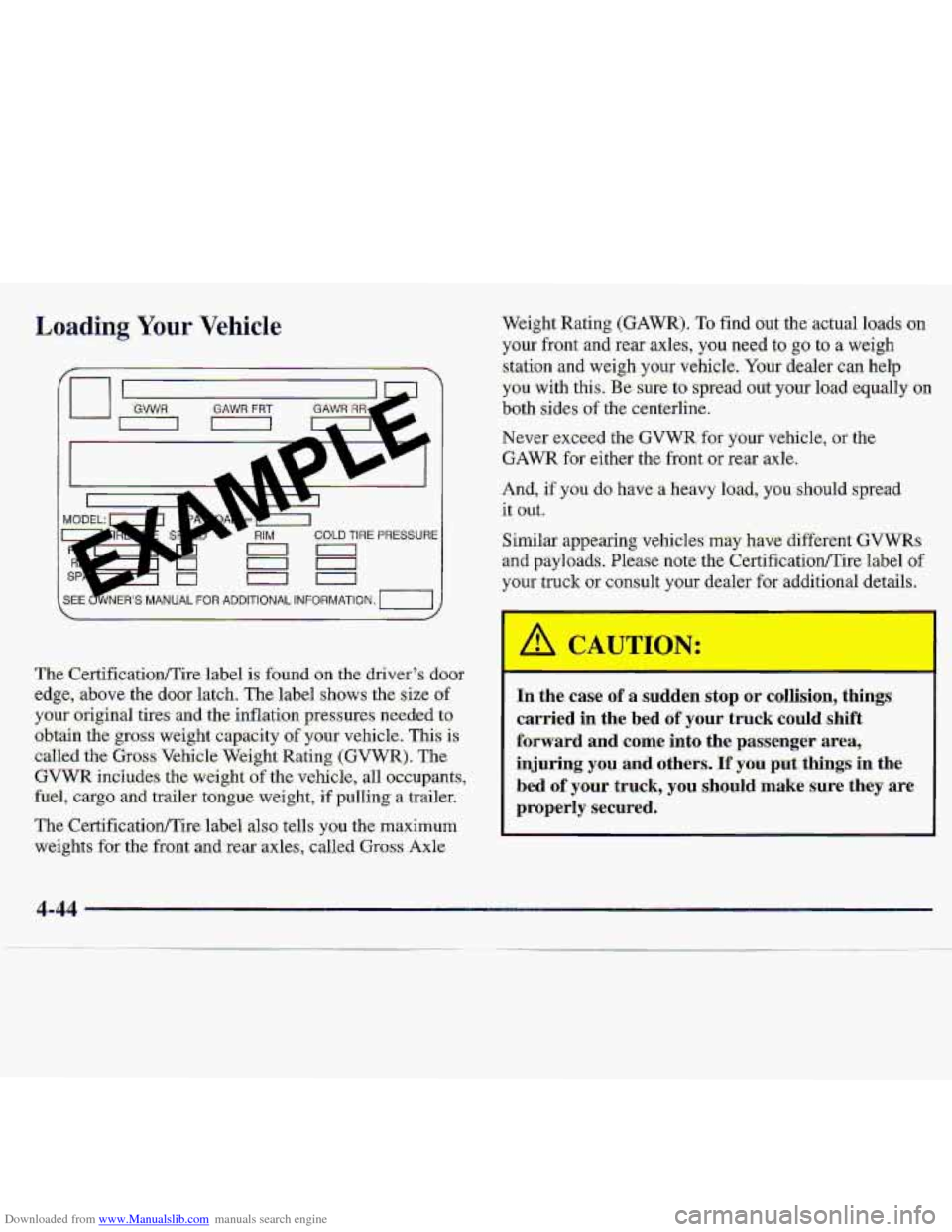
Downloaded from www.Manualslib.com manuals search engine Load& Your Vehicle
The Certification/Tire.iabel is found on the driver's door
edge, -above the door latch. The label shows the size of
your original. tires and the inflation pressures needed to
obtain the grass weight capacity of your vehicle. This is
called
the Gro-ss- Vehicle Weight Rating (GVWR). The
GVWR
includes the weight of the vehicle, all occupants,
fuel,
cargo aild trailer tongue weight, if pulling a-trailer.
The C&tification/Tire. label
also tells you the maximum
weights for the front and-re,ar axl.es, called Grass Axle Weight
.Rating (GAWR).
To find Qut the actual loads on
your front and rear axles, you need to go to a we.igh
station and weigh your-vehicle. Your dealer
can help
you with this. Be sure to spread out your load equally on
bath sides of the centerline..
Never exceed the GVWR for your vehicle, or the
GAWR
hi either the front or rear axle.
And, if you do have a heavy load, you- sho,uld spfead.
it
out.
Similar appearing vehicles. may have. differeQt GVWRs
and payloads. Please note the Certificatioflire. label sf
your truck or consult your dealer for additional details.
In the.case of a gudden stop or collision, things
carried in the bed of your truck could shift^
forward and come into the passenger area,
injuring you and others. 'If you put things in the
bed of your truck, you should rnake.su.re they are
properly
secured.
I
Page 186 of 402
Downloaded from www.Manualslib.com manuals search engine Towing -a Trailer
I
11 you don’t use the correct equipment and. dr-ive
pruperly,
you can lose control when you pull a
trailer. For ex.ample, if the trailer is too heavy, the
brakes may not work well
-- or, even at all. You;
and your passengers could be seriously injured.
Pull a trailer only if-you have followed ail tIie
ste:ps in
this sectiw. Ask your GM dealer for
advice and information about towing a trailer
with your vehicle.
NOTICE:
Pulling a: trailer improperly can damage your
vehicle and result
in costly repairs not covered by
your warranty. To puli a trailer correctly, follow
the advice in this part, and see your.
GM dealer
for important Information about towing a trailer
with your vehicle.
4-49
Page 187 of 402
Downloaded from www.Manualslib.com manuals search engine If You Do Decide To Pull. A Trailer
If you do, here are some imp-ortmt points:
Page 188 of 402
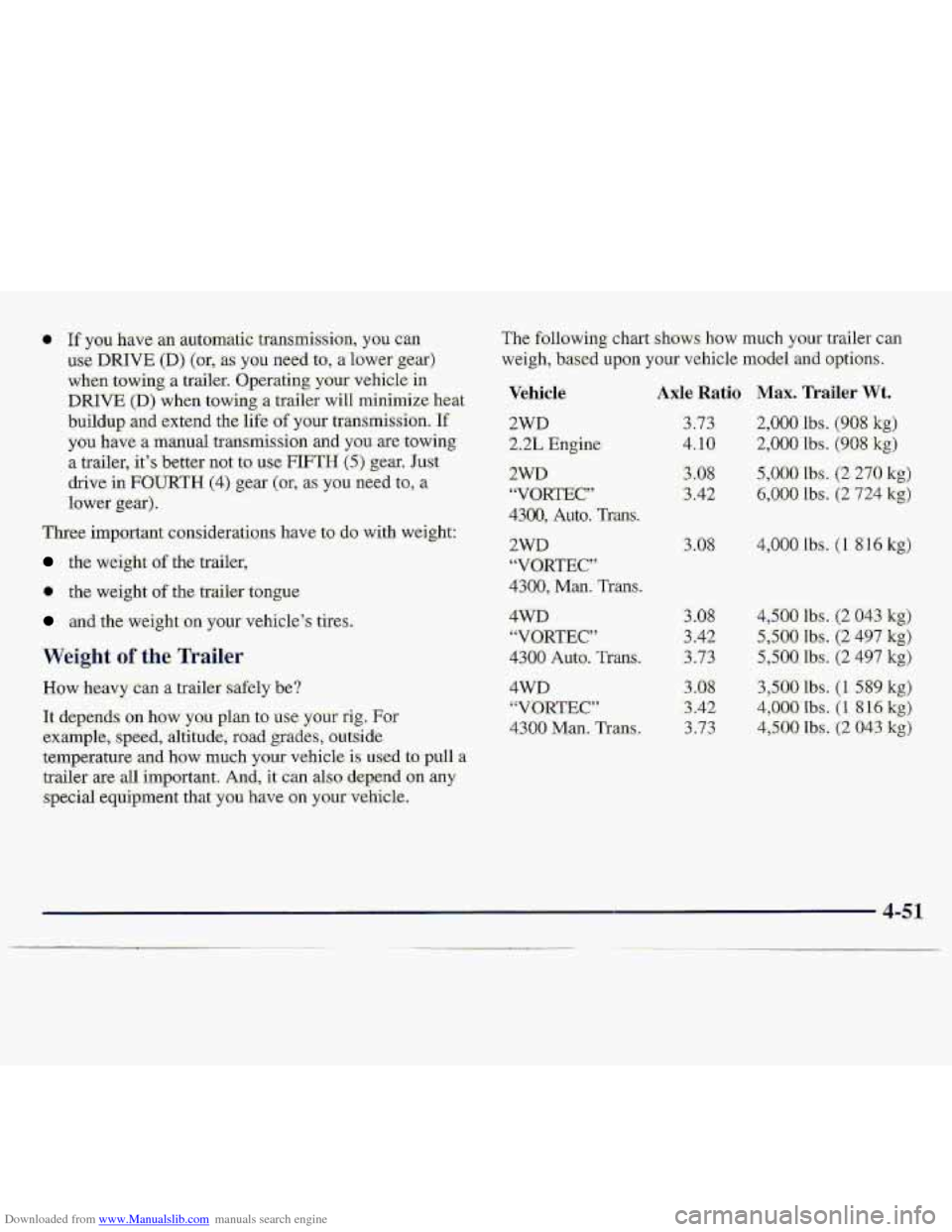
Downloaded from www.Manualslib.com manuals search engine '0 If you have- an automatic transsinission5. you can
use DRIVE (Dj (m,as you need to, a lower gear)
when -towing a.tr-ailer. Operating your vehickin
DRIVE (P) when towing a trail& will minimize. heat
buildup a-nd extend the life of your transmission. If
you have -a manual eansmission and YQU'W~ towing-
a trailer, it-'s :better not to 'use FIFTH (5) gear. Just
drive in FOURTH (4). gear (or, as y-ou necd to, a
1Qwer ge.a).
Three importmt considerations have to do. with weight:
the; weight Qf the- trailer,
0 the weight of the traiirer?tongne
and the weight on-your vehicle's tires.
Weight of the Trailer
How he-avy can - a trail& safely be?'
It depends on how yosll plan to use your rig. For
example, speed, altitude, mad grades, outside
-temp&ature and how much yaw vehicle is used to pull a
trailer are -all important. An,d~, it can also depend an any
.-special equipment that you have on your vehicle.
The follo-w%g chart shows haw much your trailer can
weigh, based upon your: vehicle rno.&l and. options.
Vehicle
2wD
2.2L Engine:
2wJ-J
'VOREC"'
4300, Auto. Trans.
Axle Ratio Max. Trailer Wt.
3.73
4.10
2,000.Il.?s. (90.8 kg)
2,000 lbs. (908 kg:)
3 .m
3.42
5,000.lbs. (2 270 kg)
6,O.OO lhs. (2 724 kg)
3.08 4,000 lbs. (1 g.16 kg)
4m 3.08
"VORTEC" 3 -42
4300 Auta:. Trans. 3.73
4.,500 hs. (2 043 kg)
5,500 1b.s. (2 497 kg)
$,5OOllbs.. (2 497 kg)
3,500 ibs. (I 589 kg,)
4,500 lbs. (2 043 .kg)
4,000, lbs. (1 8 1.6 kg)
Page 189 of 402
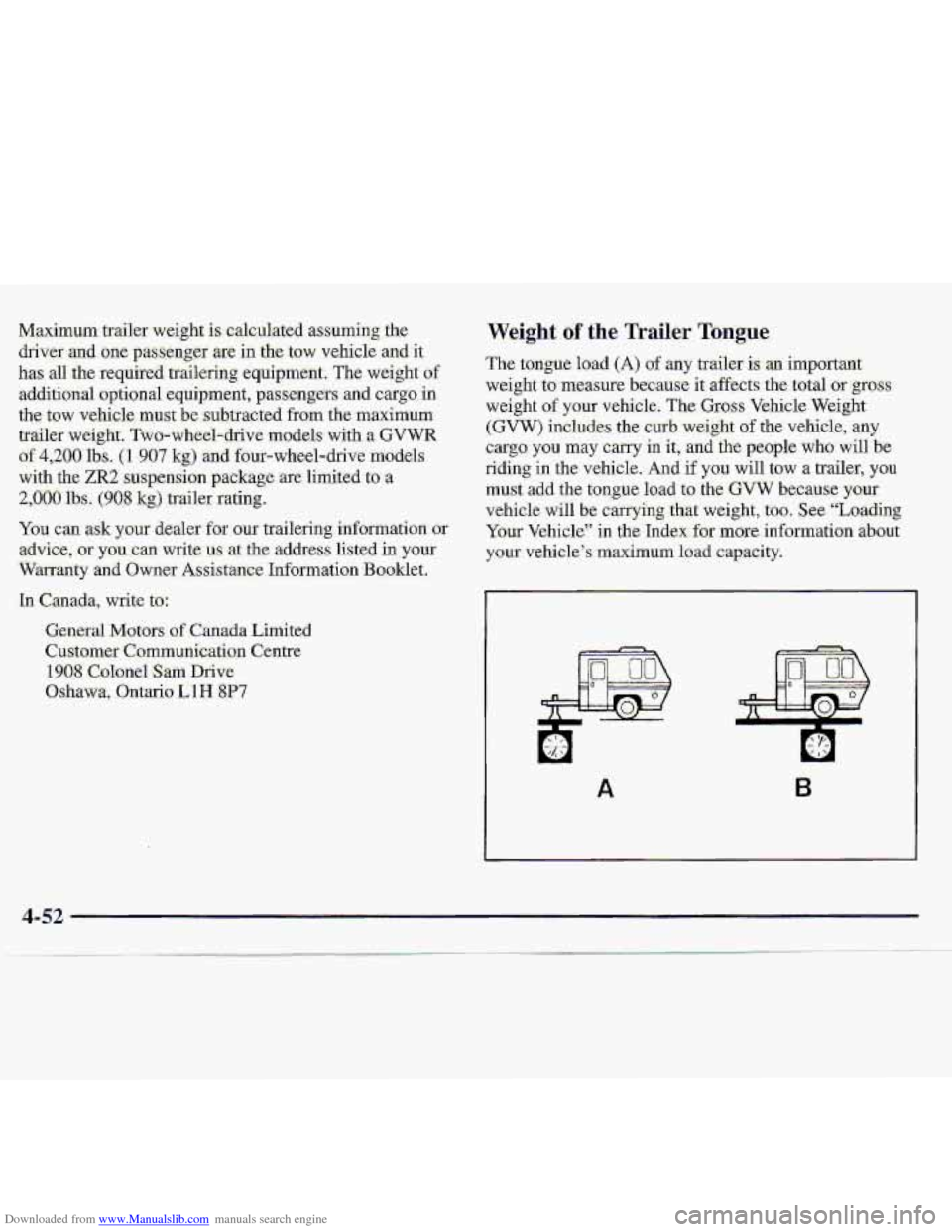
Downloaded from www.Manualslib.com manuals search engine M.ax-irnW trailer weight is c-alculated assu~qg :the
driver and one. pesseiger are in the tow vehicle- and it
has till ,the required traiiering equipment; The weight of
additimal optional equipment, passieiigers- and cargo in
the tow vehicle, must be sub,jxac.f,ed from the maximum
trailer weight Two-wh&I-drive models with a. GVWR
of 4,20ci lbs. (L9O7 kg) and. four-wheel-drive models
w& .&e ZR2 suspen&an package are limited to a
2,@001bs. (908 kg) .trailer rating.
YOU can .ask yaur dealer for our trailering information or
advice, or you.,cm write us. at the address’listed in your
Warranty and Owner Assis;taace. Information Booklet..
In Canada, write t~:
Weight of the Trailer Tongiue,
The tongue load (A) of any trailer is- an important
weight to.
measure because it affects:the. total or.-gross
wei.ght of your vehicle. The Gross Vehicle Weight
(GVW) includes the curb weight of the vehcle, any
cargo you may c.my in it, and the people who will be
riding in the vehick. And..if you will tow a trailer, you
must add the ton
vehicle. will be carrying-that weight, too. See “Loading
Your Ve.hic1.e’’ -in the In&x for ‘more information about
your vehicle’s maximum-laad capacity.
A B
Page 192 of 402
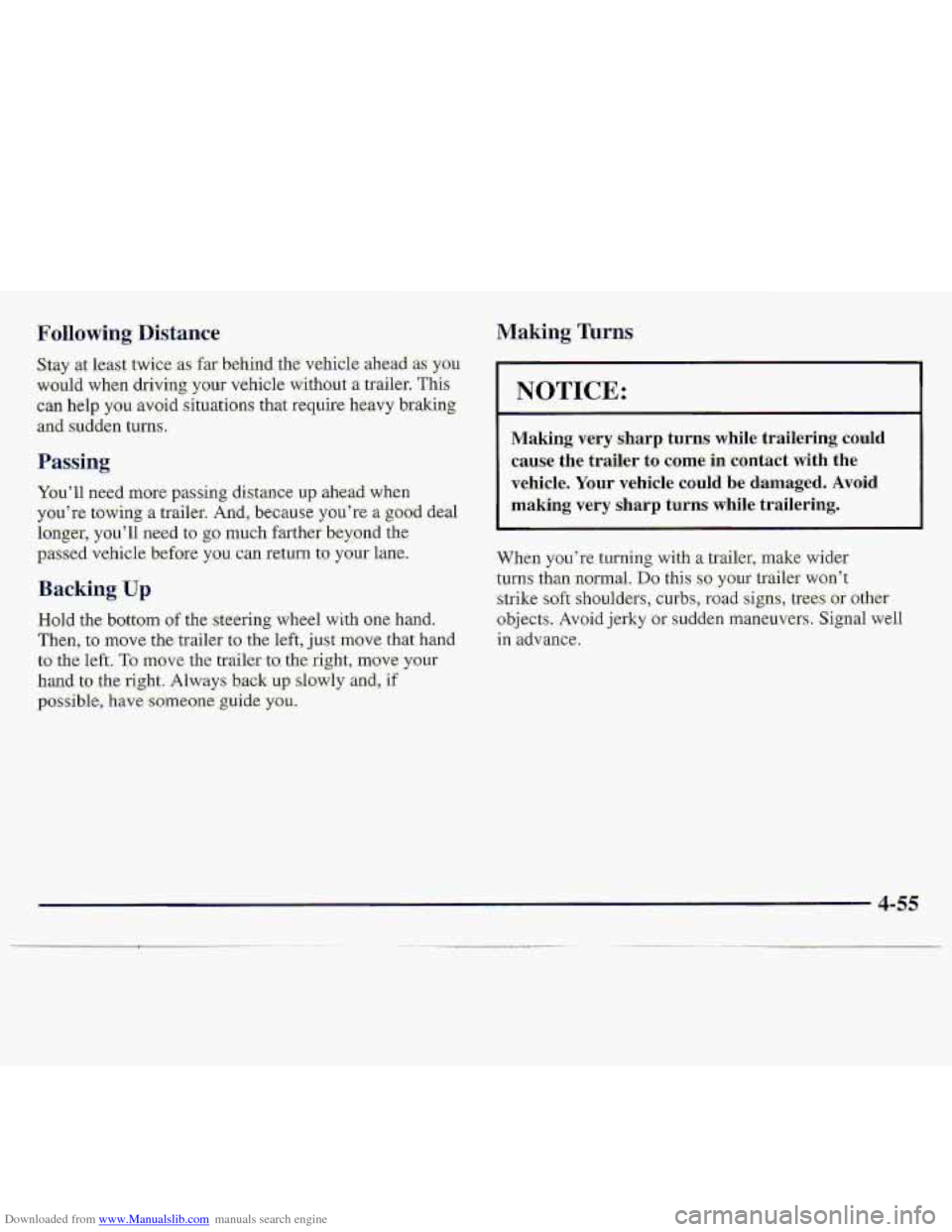
Downloaded from www.Manualslib.com manuals search engine Following Distance
stay at least twice as far behnd-the vehicle ahead-as YOU
would when driving your vehicle without a trai1e.r. This
Can help y.ou avoid situations that require heavy braking
a~d sudden turns.
You’ll need more passing distance-up ahead when
you’re tawing a trailer. .And, .because you’re a good deal
lmgei-,. you’11. need to go much farther beyond the
passed,.vehicle, before. you. can rexurn tp your larrc.
M.aking Turns
NOTICE:
Making very sharp turns while traileririg could
cause the trailer to come in contact with the
vehicle.
Your vehicle could be damaged. Avoid
1nakin.g very sharp turns while trailering.
Backing Up
Hold the. battom of the -steering w’heel with- one nand.
Then, to move the- tr.ai1e.r to the left, just mQ~e that hmd
to the left. To. move the trailer tof the-right, move your
hmd.t.0 she right. Always back up d-owly if
possible, haveSorneone ,guide ycau.
~~~~~ ~~~~
Wkfm ‘Y6u’re turning with .a trauer, make wider
turns than normal. Do this
so your trailer won’t
strike soft shoulders, curbs, road signs, trees .or other
objects. Avoid jerky or sudden maneuvers. S,ignal well
in advance.
4-55
Page 193 of 402
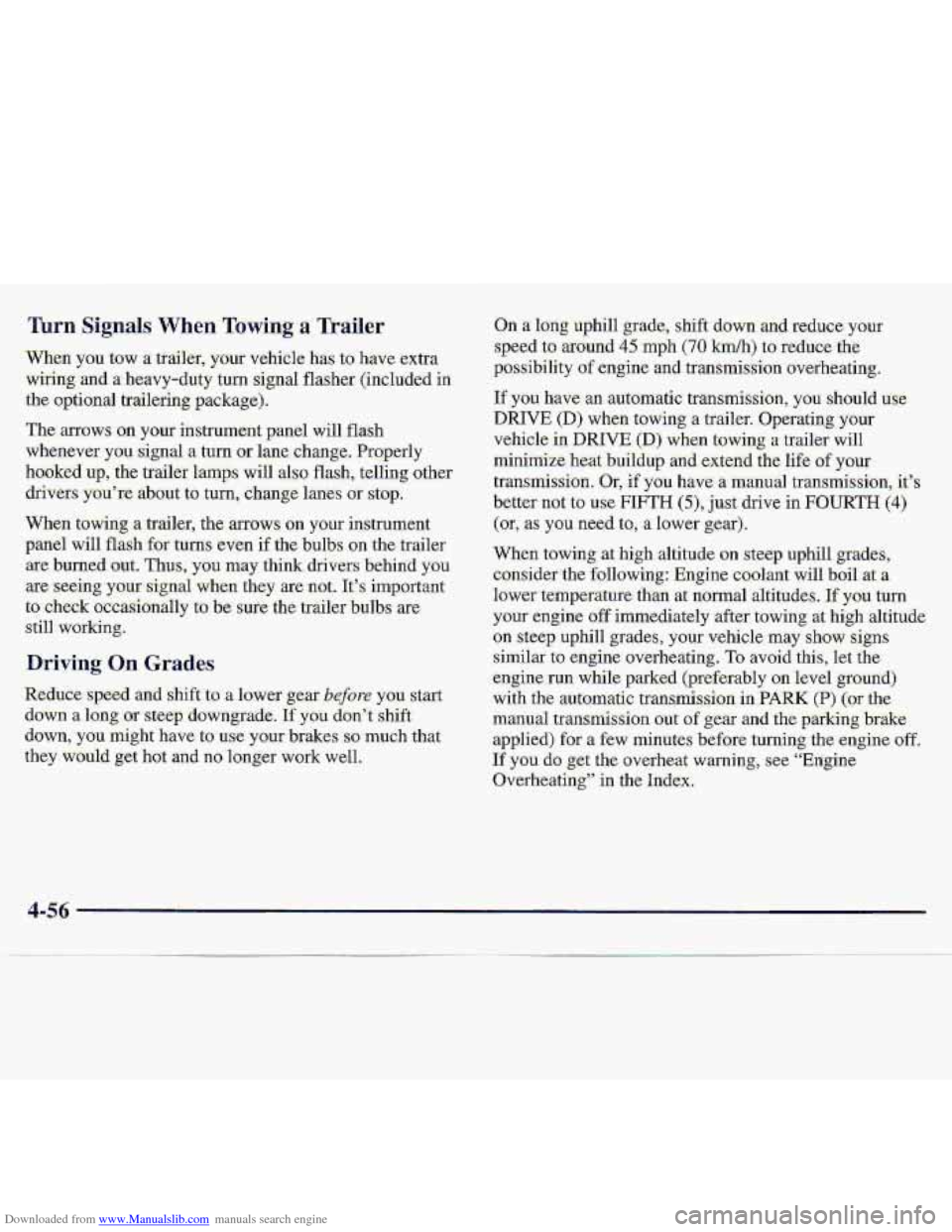
Downloaded from www.Manualslib.com manuals search engine When. you tow a tixiilkr, y-our vehicle ha.s to’have extra
wiring :and a- heavy-duty turn signal flasher. (included in
the- optional trailering package).
The arrows-on your instrument panel will flash
whenever.
you signal a turn 01- 1-me. change, Properly
hooked .up, the &&la lamps will also flash, telling other
drivers you’re
about to :turn, change lanes or stop.
When towing a:txailer,
the. arrows. on your hstrument
panel will flash for turm even if the bulbs on the trailer
are burned out. Thus, you may think drivers behind you
axe seeing your signal when they arenot. ICs important
to check. occasionally to.be sure- the trider bulbs are.
still working.
Driving On .Grades
Reduce speed and shiftlo dower. ge.ar. ,befure you start
dawn B long -or steep downgrade. If-you do-n’t shift
down,
you might have to use your brakes wmuch that
they would
get hot and no longer work weIl.
If you have an.aut~~atic-transm~ssion, you should use
DRIVE (D) when towing a trailer. Operating your
vehicle in DRIVE @) when towing a. trail& will
Mze: heat:buiidup and merid the life af y.our
transmissioil. Qr, if you have, a-manu-ai transmission,
it’s
better not to use FIFTH (S), just drive in FOURTH (4)
(or, as you need to, a lower gew).
4-56